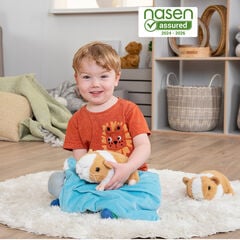In this blog, Rachel Gelder and Pamela Hanigan, both SEN experts, explain how and why they have created a ‘Calming Cube’ and calming areas to support the children within their setting.
In this blog, Rachel Gelder and Pamela Hanigan, both SEN experts, explain how and why they have created a ‘Calming Cube’ and calming areas to support the children within their setting.
Calming Cube
Our school, like many others, is seriously lacking in available spaces for children with sensory or behavioural needs, to be able to ‘escape’ from the overload they can frequently feel, within a busy, working classroom.
The ‘Pop-Up Sensory Space’ from TTS – or the ‘Calming Cube’ as it has affectionally come to be known at Lytham CE Primary School – has provided a welcome and effective solution to this need.
The ‘calming cube’ should ideally be located in an area of school which is away from classrooms and, if possible, corridors. As this is a ‘pop-up’ solution, it can be easily moved to fit in with the changing needs of children within school. We opted for the white version of the cube as this blended far more easily within our school environment.
When placing the cube, consideration should be given to providing somewhere that affords the child using it, some privacy and reduced stimulation, but also ensures that any disruption to other children is kept to a minimum. Our ‘calming cube’ is now an essential multi-use and valuable resource which supports, not only sensory needs, but also acts as a nurture area. This appealing and comfortable space also provides an area where additional learning can go on, such as small phonics groups.
Explore our full range of sensory space resources
Resources
The ‘Emotions Faces Interactive Rug’ from TTS provides a great base for our ‘calming cube’. We have also placed a selection of cushions of different textures within this. Emotions cushions could also be used as an alternative. Lighting has also been added, however is not used with all children as although it can be calming for some, it can act as a stimulant for others.
We have put together a number of resources to support children who use the calming cube. These are in the form of a series of boxes kept in a storage unit nearby. They each have their own unique function and related resources. For us, these are: calming, emotional regulation and frustration/anger. Obviously, these can be adapted for the needs of your own setting and often resources are transferable.
Calm in the Classroom
Due to the success of the calming cube in our school, we have developed ‘calm areas’ within each classroom. These are a ‘potted’ version of the calming cube and follow the same principles and using the same resources. Additionally, we have found that using a Sound Field System, which filters out background noise, has contributed to the calm ‘feel’ of the classroom.
Whilst the ‘calming cube’ has provided a space saving solution to our need as a school for a sensory space, the principles behind it have had a wider impact, helping us to create a ‘calm school’.

Find out more about sensory spaces
With many thanks to Rachel Gelder and Pamela Hanigan from Lancashire Dyslexia, Information, Guidance and Support (LDIGS) for writing this blog about their Calming Cube set up.
Rachel Gelder joined the NHS on leaving university, working in Oxford and London in a variety of management, project management and contract roles, eventually specialising in Mental Health, including time in Broadmoor Special Hospital. Whilst her two boys were young she decided a change of direction was needed, moving north to live in Lancashire and into education. Rachel is a Specialist Dyslexia teacher and in 2014 formed Lancashire Dyslexia Information Guidance and Support (LDIGS) with Pamela Hanigan. This is balanced with her role as a SENCo in a mainstream primary school with high levels of special needs.
Pamela Hanigan began her teaching career in 1997, in Salford Education Authority. She has continued her passion for teaching and education throughout this time, teaching and tutoring children from nursery age to Year 11. Based for the past 17 years in Lancashire, her interest in supporting children with neurodiverse difficulties and particularly with the development of reading and phonics skills grew. Pamela is a Specialist Dyslexia teacher and assessor and in 2014 formed LDIGS (Lancashire Dyslexia, Information, Guidance and Support) with Rachel Gelder. The pair continue to balance their roles in their schools, together with assessing those with suspected dyslexia and supporting schools and other professionals, through training and consultancy work relating to dyslexia.
















